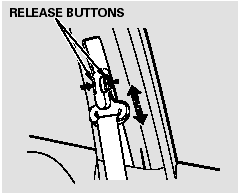Honda CR-V: Fasten and Position the Seat Belts
Insert the latch plate into the buckle, then tug on the belt to make sure the belt is securely latched. Check that the belt is not twisted, because a twisted belt can cause serious injuries in a crash.
The seat belt in the center position of the back seat can be unlatched and retracted to allow the back seat to be folded up or down. This seat belt should be latched whenever the seat-back is in an upright position.
See page for how to unlatch and relatch the seat belt.

Position the lap part of the belt as low as possible across your hips, then pull up on the shoulder part of the belt so the lap part fits snugly.
This lets your strong pelvic bones take the force of a crash and reduces the chance of internal injuries.
If necessary, pull up on the belt again to remove any slack, then check that the belt rests across the center of your chest and over your shoulder.
This spreads the forces of a crash over the strongest bones in your upper body.

Improperly positioning the seat belts can cause serious injury or death in a crash.
Make sure all seat belts are properly positioned before driving.
If the seat belt touches or crosses your neck, or if it crosses your arm instead of your shoulder, you need to adjust the seat belt anchor height.

The front seats have adjustable seat belt anchors. To adjust the height of an anchor, press and hold the release buttons, and slide the anchor up or down as needed (it has four positions).
Never place the shoulder portion of a lap/shoulder belt under your arm or behind your back. This could cause very serious injuries in a crash.
If a seat belt does not seem to work properly, it may not protect the occupant in a crash.
No one should sit in a seat with an inoperative seat belt. Using a seat belt that is not working properly can result in serious injury or death.
Have your dealer check the belt as soon as possible.
See page for additional information about your seat belts and how to take care of them.

